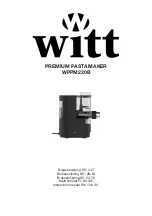
Before beginning, ensure the following:
• This water line installation is not warranted by the refrigerator or ice maker manufacturer.
• Follow these instructions carefully to minimize the risk of water damage.
• Water hammer (water banging in the pipe) in house plumbing can cause damage to refrigerator parts and lead to water leakage or
flooding. Call a qualified plumber to correct water hammer before installing the water supply line to the refrigerator.
• To prevent burns and product damage, do not hook up the water line to the hot water line.
• If you use your refrigerator before connecting the water line, make sure that the ice maker wire signal arm is in the OFF position.
• Do not install the ice maker tubing in areas where temperature falls below freezing.
• When using any electrical devices (such as a power drill) during installation, be sure the device is double insulated or grounded in a
manner to prevent the hazard of electric shock, or the device is battery powered.
• All installations must be in accordance with local plumbing code requirements.
• Minimum/Maximum inlet water pressure, 138/827 kPa (20/120 PSIG).
12
Installation Instructions
CONNECT WATER SUPPLY
□
□
□
□
□
□
□
□
□
Disconnect the refrigerator from the electric wall outlet.
Remove the parts in the water line kit that you purchased for this purpose.
Connect the end of the water supply line to the household cold water line behind the refrigerator. Choose a location for the valve that is
easy to access. We recommend that you connect it to the side of a vertical water pipe. If it is necessary to connect it to a horizontal
water pipe, make the connection to the top or side, rather than at the bottom, to avoiding drawing off any sediment from the water pipe.
Make sure that the household water supply is turned off, then drill a ¼” hole in the water pipe (even if using a self-piercing valve), using
a sharp bit. Remove any burrs resulting from drilling the hole. Take care not to allow water to drain into the drill. Failure to drill a ¼”
hole may result in reduced ice production or smaller cubes.
Fasten the shutoff valve to the cold water pipe with the pipe clamp, then tighten the pipe clamp screws until the sealing washer begin
to swell. Do not over-tighten or you may crush the tubing.
Route the tubing through a hole drilled in the wall or floor (behind the refrigerator or adjacent base cabinet) as close to the wall as
possible.
Connect the tubing to the valve by placing the compression nut and ferrules (sleeves) for copper tubing onto to the end of the tubing and
connect it to the shutoff valve. Make sure that the tubing is fully inserted into the valve.
Tighten the compression nut securely. For plastic tubing, insert the molded end of the tubing into the valve and tighten the compression
nut until it is hand-tight, then tighten one additional turn with a wrench. Over-tightening may cause leaks.
Place the end of the water supply line into a sink or bucket and flush the water supply line with water until the water runs clear.
WARNING:
The ice maker should be installed by an authorized service technician.
WARNING:
Make sure that the refrigerator is unplugged to eliminate the danger of electric shock during installation.
WARNING:
Connect to potable water supply only.
NOTES:
• Make sure that there is sufficient extra tubing to allow the refrigerator to move out from the wall after installation.
• Before making the connection to the refrigerator, be sure the refrigerator power cord is not plugged into the wall outlet.
• If your refrigerator does not have a water filter, we recommend installing one if your water supply has sand or particles that could clog the screen of
the refrigerator’s water valve.













































